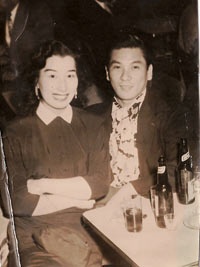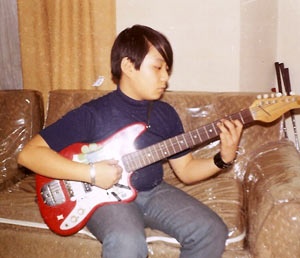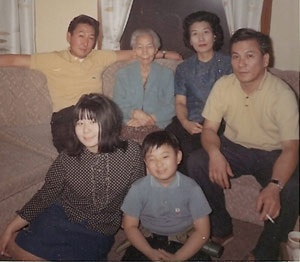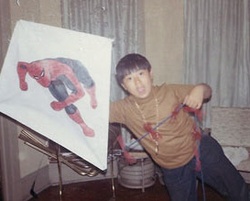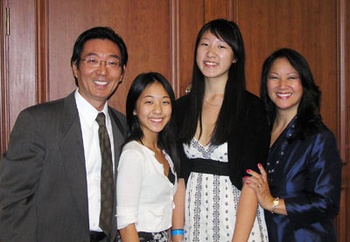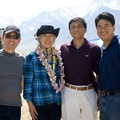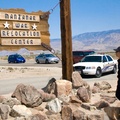Normally, I am a fearless writer, but this commission from the Chicago Japanese American Historical Society (CJAHS) has created endless procrastination, writer’s block and even fear for this author. For months, I could not figure out why- but today, it hit me. My generation is hard to define. We’re not supposed to be “too open,” show our emotions or attract attention- all cultural remnants from being racially profiled in America during WWII. We Sansei (Third Generation Japanese American) are furthering the transition that our parents (Nisei) and grandparents (Issei) pioneered, yet we remain largely invisible. Our assimilation is relatively smooth. Our attempt at not drawing too much attention to ourselves has been successful, perhaps to a fault. As our society becomes truly integrated, there are a certain percentage of us Japanese Americans (JA’s)-who assimilate well enough to “dissolve.” That is, to integrate well enough remove one’s self from the Japanese American community entirely. Herein lies the conflict. Is this success? Many of us marry partners from another ethnic group/heritage.
My lovely wife Betty has her own amazing stories from her Chinese American perspective that are indeed worthy of “Joy Luck Club II.” As this wonderful integration progresses, there is always riches gained and treasures lost. There is so much that we Sansei have seen as the bridge from the old thinking to the new. Frankly, there is no way to nail down all the complexity and diversity of the Japanese American existence since the exodus from the U.S. prison camps as WW II ended, so I decided to simplify and tell the story from my perceptions as a child growing up in the community…
It’s the little things. The memory flashes. The swatches of people and events. The smell of Bachan’s (Grandmother’s) cooking on New Year’s Day. The sound of Hawaiian ex-G.I.’s singing and strumming their ukuleles- drunken, lovelorn and red-faced from the beers I brought to them at the holiday parties. The contrasts. The “Jekyll and Hyde existence” of watching “The Dick Van Dyke Show” or “I Love Lucy” then going down to the Buddhist Temple of Chicago (B.T.C.) to watch the Obon dance. Those weird, “tinny” Japanese records playing through those piercing gray metal speaker cones in the middle of Leland Avenue. Who could forget that crazy Nihonjin (Japanese) taiko drummer with the kamikaze headband who performed in such a lovely maniacal fashion up on the platform? Entire troops of Japanese American boy scouts and cub scouts. How about the Grant Park softball diamonds on a summer Sunday completely overrun by JA’s? Unique to us? Definitely. How do I begin to describe those experiences to my kids?
My mother Ruth came to Chicago with her mother and brother straight from Manzanar after WW II ended. It is tempting to go into the internment issue, but I am certain that the subject has been covered with greater skill and detail that I could ever recreate second hand.
My father Kurt left his home in Honolulu to get his Master of Arts from the University of Colorado before the events at Pearl Harbor. He fell in love with the mainland. His existence during WW II was less affected since he was inland, but nevertheless, he tread carefully during the war years at college. He decided to come to Chicago after the war. The “buzz” was that there were jobs for Japanese Americans. Factory jobs, but what else could they do? Being Japanese American made you a suspect of treason, way before this concept of “racial profiling” even existed.
It was in Chicago where my parents met. Their first date was a movie at the Uptown Theater, and dancing at the Aragon Ballroom. What a glorious evening that must’ve been. Given the times, they were pretty hip, because I have seen some pretty slick photos of them “clubbing” at Club DeLisa on the South Side, where they would listen to legends like Billy Eckstein, Ella Fitzgerald and Sarah Vaughn. The photos show my mom all “dolled up” and my dad in a very sharp suit with pomade slicking back his jet-black hair. All the women at the table have Joan Crawford hairdos- and there is a huge bottle of Seagram's on the table. Hmm. There is a lot I still don’t know about them! They married and settled on Elm Street, eventually moving to Oak Street at Clark.
After a series of factory jobs, my folks took a brave risk and bought Kurt and Ruth Dry Cleaners on the 1100 block of N. Dearborn. Clark and Division streets were humming with activity. While the majority of Nisei were busy trying to assimilate and make ends meet, there was a rogue group of young Nisei men who took a different route. It was around this time when the legendary Nisei gangster Montana Joe, a.k.a. Ken Eto, was making his mark around Clark and Division. Some forty years later, I chronicled his rise and fall in the play “Seven Out.” When I was researching the drama, I was told about the Nisei-run gambling house in back of the barber shop at Clark and Maple. Montana Joe and some of the neighborhood Nisei fellas would help him run the joint. One day, one of Montana Joe’s top lieutenants came knocking on our back porch door. His hand was bloodied from some kind of brawl in the alley. My mom bandaged his hand and he was on his way. Just another day at Clark and Division.
In spite of all the vice in the neighborhood, it was a glorious time for kids. We didn’t know we were poor. Amidst the immigrants, down-and-outers, gangsters, call girls, Issei and Nisei, I rode my tricycle around that neighborhood as if I owned it. I can still recall the pungent smell of beer as I entered Bronco’s Anchor Bar. I can’t remember how or why I was allowed in there, but I can still envision exactly how it looked and smelled.
My sister Karen remembers going on dry cleaning deliveries with my dad. I have heard tales of dad getting winks and generous tips from the platinum blond showgirls who strutted across the stage at Talk of the Town -as he delivered their sequined gowns!
Karen was a bit older and was a lot more aware of the difficulties, racism, and corruption, but I was just a kid who thought all of this was normal. Years later, she would tell me tales about what she observed at the colorful local joints called Ting-a-ling, Rainbow Restaurant, Ding Ho, and the Rib House.
Although most of our dads managed to stay on the straight and narrow, many of them would sneak off occasionally and play some “pai que” or “bak a pei”- Chinese gambling games, or run off to the track when one of the guys got a “hot tip” from Montana Joe’s crew.
This was a wild, wooly and rich time in Chicago’s history. The politicians and big shots were not ashamed to run the show any way they seemed fit. As soon as we could afford it, we moved further north to a little “island” in Uptown- The Morioka’s 6 flat at Kenmore and Wilson. Karen attended Senn High School and became very involved with the plight of Chicago’s impoverished. She joined the original Uptown Peoples Planning Coalition started by Chuck Geary, a political activist. It was the sixties and, through her, I learned about the Beatles, John Kennedy, Simon and Garfunkle, the Hippies, the Yippies, Abby Hoffman and the Chicago Seven.
After Karen made the entire family sit in front of the TV to watch the Beatles on “The Ed Sullivan Show,” I grabbed my dad’s old Gibson guitar and started playing. Being a super cool sister, she took me to the Amphitheater to see a WLS rock music convention. I saw Tommy James and the Shondells, the Troggs, Paul Revere and the Raiders and a slew of others. I was grateful for that. What big sister would voluntarily bring her little brother to a concert? Music became my passion.
For the most part, I believe that my generation was relatively happy and carefree. I was going to the cub scouts at B.T.C. and occasionally ditched scouting to watch “The Partridge Family” and “The Brady Bunch” on Friday nights. Stewart School in Uptown was made up of the most diverse ethnic makeup I have ever seen. Appalachian whites from the mountains, blacks from the South, Hispanics, Asians and, among others, a rare and slowly fading population of American Indian kids. We were all tossed together in this incredible melting pot on the north side called Uptown. Only in my adulthood did I realize how privileged I was to be exposed to this diversity. It was around this time when there was a huge influx of East Indian and Korean immigrants as well.
When I think of my youth in the 60’s, the following images appear:
It’s a perfect summer in Chicago and school is out. There is an apartment building in Uptown -just like hundreds of others except one unusual thing: every single apartment is occupied by a Japanese American family. Through some kind of miracle, almost every household in this six-flat had boys pretty close to my age. If this were a Scorcese film, the camera would be panning across these faces: There was Donny and “Kenbo,” Bobby and Brian, Kirk, Nick and Dirk, and Darryl, Rusty and me. Nearby, there were other similar clusters of families. Let’s see. There was Kenny, Keith, Steve and Scotty, Kevin and Colin, and Frankie and Russell.
Unbelievable when you think about it. There was always someone to play with. Always someone to get into trouble with, too! There was: softball at Grant Park; basketball at Olivet Institute’s gym or out back with the African American kids; bowling at Marigold and the Bowlium; hockey in the icy alley in the winter; and of course, Cub Scouts at the Temple and Boy Scouts at Owassippe, not to mention all the illegal fireworks in the summer. Given our pyrotechnic experiments, it’s amazing we all still have our fingers!
So it’s the 60’s and there are these little “islands” of JA’s in the Uptown neighborhood, but we were soon to discover that Hyde Park had the same thing going on. As most of you who hung around then can testify, all the young guys of all races connected on one thing… sports. And I gotta tell ya one amazing thing…
Outside of a few scrapes here and there, the entire multi-ethnic community pretty much got along back then. In fact, aside from the winos that slept in the vestibule of our apartment building, and getting my dad’s Delta 88 stolen and “torched” on the day of my Bachan’s funeral, we got through relatively unscathed!
Okay, back to Sunday morning… we chow down quickly, grab our softball mitts and jump into Big Donald Nishibayashi’s shiny white Ford Fury. No seatbelts and windows wide open as we squirmed around on the scorching hot red vinyl interior. Lake Shore Drive had a high speed limit and a very sharp “S” curve back then, but Big Donald always looked so confident as he slung that Ford down L.S.D. with 5 or 6 of us scrunched up in the back seat with our Beatles haircuts flapping in the wind. Back then, we always found street parking on Balbo near the diamonds. I think the meters cost five cents an hour. Currently, I believe it is five cents per second, but you must wait an hour to find one. Now here is the part that I’ve tried to explain to my two daughters…
Picture this: Sunday in Grant Park, we exit the car with all our softball gear, look out at the massive cluster of softball diamonds, and the entire field, as far as the eye can see- is swarming with hundreds of - not just Asian Americans, but Japanese Americans. Men’s teams, boys teams, ladies and girls teams, kiddie teams, and of course those evil, green-clad, semi-pro Galaxies! Frankly, I don’t even think we will ever see that again in Chicago. This was every Sunday during the summer. Even now, I can’t believe how us kids took this all for granted.
Good report cards were expected of us, but somewhere, somehow, it became all about the sports- another remnant of the camps, perhaps. What an amazing chance for us to feel as if we belonged to something bigger! A chance for all the churches to connect, a chance for all the community to express its competitive spirit, and most importantly, it gave us guys a chance to check out all the girls, because thank God/Buddha- Sundays were co-ed. Yes, let’s face it. Most of us adolescents were there for two reasons: 1. the joy of competition, and 2. mainly to check out which churches had the hottest looking girls. Am I wrong? And come to think of it, most of the girls were really good looking. Or perhaps I was hitting puberty at that time! The mind is a terrible thing to waste, neh?
Anyways, it was fast pitch windmill style softball and I loved playing catcher for my childhood friend Donny “Nish” who was arguably the fastest and most dangerous pitcher in the league. Some of the most talented, hardest hitters would tremble as he would wind up and fiercely deliver a searing fastball. The older kids could pick on us all they wanted the rest of the time, but when Donny and I wanted the pitch to come “way inside,” those guys gave us respect! I couldn’t hit very well, but I would gladly sacrifice my body as a catcher for the B.T.C. team! I actually attribute my recent knee surgery to the “joyful time” I spent getting banged up for the CNAA! My favorite sounds: 1. Donnie-boy’s hardest fastball slamming into my catcher’s mitt after striking out some cocky “A” league hot-shot, and 2. the sound of Pete Izui’s bat cracking the ball so hard -that the home run went clear past the OTHER diamond. Good times for sure.
My parents were still active socially -bowling at Marigold, golf with the Kamaiina club, (one of the 3 or 4 Asian-based golf clubs) and poker games. Ah, the poker games. The ear-shattering “clatter” of those cheap, plastic poker chips and the cackle of Nisei laughter which served as the background for whatever mischief us kids were trying to do.
Summer was full of fast-pitch at Stewart School, hittin’ golf balls at the driving range and picking horses with my dad at Sportsman’s Park. Winters were full of loud poker games for the parents, and us “punks” begging for quarters to blow in the hockey machine at Marigold bowl.
Oh yeah - the Cub Scouts and Boy Scouts. It was there where we met an entire South Side contingent of J.A.s. Much like the racially diverse neighborhoods on the north side, Hyde Park area seemed to be a safe place for post war Japanese Americans to settle. Camp Owasippe was an enlightening opportunity for us “city-rat” kids to learn about roughing it. After one day with the mosquitoes, most of us were ready to go home to mom’s cooking and TV, but we ended up joyfully watching the first moonwalk on the mess tent T.V. while drinking a beverage called “bug juice” instead! The pinewood derby was supposed to be for the boys. I carved the heck out of my crappy looking little car, but I was shocked to see that this was where some of the dads expressed their highly competitive nature by building their son’s little race cars as if their lives depended on winning. It’s hard to compete when other scouts are bringing in aerodynamically tested cars with spray painted graphics. One fine day, I won a “best design” for my Spider Man design at the kite flying contest at Cricket Hill. Later that day, I got mugged at the Museum of Science and Industry by some bigger kids. Ah, those fond scouting memories…
There were Christian, Buddhist and Presbyterian churches all tied together by ethnicity and culture. Very unique. There was BTC, MBT, CCP, Tri C, Lakeside and others. I know that many of our youth were driven by their faith, but to many of us, what mattered most was which church had the best teams and the coolest social climate. Or maybe it was just me who was so shallow, but I think not! Nevertheless, the Issei remained the backbone so that the Nisei could raise us in these “good times.”
During this stretch, the Resettler’s Picnic was going strong. We kids had no idea that the Resettler’s Picnic was a chance for all of those Nisei and Issei who were displaced by the relocation camps to gather. We just knew it was really great event with games, prizes, bento and most importantly, all those weird flavored canned sodas that we never got at home. Grape? Cream soda? As much as you could drink? Yes! – all those icy cans were sitting in those big metal tubs of ice water. Remember the feeling of dipping your arm in to get one? Priceless.
For 7th and 8th grade, many of us went to Stockton Uppergrade center, a block away from the current JASC building. More diversity. Older kids. Some of the neighborhood conflicts and issues became more serious for the kids as we all got older. Some innocence got lost at Stockton.
The frenzy to get into Lane Tech. This was the beginning of the Chicago High School fierce competition phenomenon. We knew of one father who went down on orientation day and tried to pay cash to get his kid into Lane. Now that I have two kids heading into high school, I realize that the high school has actually become MORE competitive. If I have grand kids, I will be sure and hire nursery school tutors so they can get their algebra/trig out of the way early!
It was around this time when I was getting involved in the music and theater community. Sadly, most of my early Sansei crew had become dispersed, and I was probably the most guilty since I started a long journey into the creative arts.
Perhaps the most amazing things I’ve discovered about getting older- is that I see myself acting more and more just like my late father, Kurt. You remember all those old guys who just sat around at Marigold “talking story?” Well, lately, whenever I run into someone from the old days, we get lost in reminiscing about our misadventures- who’s doing what, who’s still around, who’s disappeared, and lately – who died or who’s KID got divorced! Ai Ya! Here’s the kicker. I see my daughters standing around rolling their eyes in mockery, waiting impatiently for me- just like I used to wait around for my dad to finish “shooting the breeze.” My Bachan used to call this “Ba-chi,” loosely translated as “You shouldn’t have done that, see what karma you get?”
What will the next generation of Japanese Americans life bring? Will there be any traces of our unique history as our kids carry on? I only hope my daughters are able to find a rich and wonderful collection of memories that are as culturally meaningful and beautiful as mine.
This remembrance is dedicated with love to my parents: Kurt Toshiro, Ruth Chiyoko and “Bachan” Chiyo, and my sister Karen, who broke all the rules first- and “took the heat” so that I could have it a little easier.
Mom came full circle when she ended her journey in a hospital bed in the Barr Medical Center Hospice on Clark and Maple. Special thanks to the Na Kupuuna Ukelele club whose unconditional loving spirit keeps the Nisei connected and purposeful. For those of you who don’t know about them, they are the most amazing group of Nisei and friends who keep each others’ spirits, bodies and minds strong and proud. My generation should be so lucky. Much praise to the CJAHS for being the keepers of our precious, unique history.
* This article was originally publised in the Voices of Chicago by the Chicago Japanese American Historical Society.
© 2007 Chicago Japanese American Historical Society




